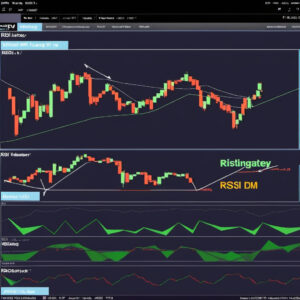In the fast-paced world of the stock market, spotting trends is like finding the wind in your sails—it can propel your portfolio to greater returns if you know how to ride it. Trend trading is one of the most popular and effective strategies for investors looking to achieve higher-than-average stock market returns. Let’s explore some top trend trading strategies and how investors can use them to make money in the stock market.
1. Moving Average Crossover: A Simple Yet Powerful Strategy
Moving averages (MAs) are one of the most widely used and straightforward indicators in trend trading. They help smooth out price data over a specified time period,  making it easier to identify the general direction of a stock’s price. There are different types of moving averages, but the most common are the simple moving average (SMA) and the exponential moving average (EMA). The moving average crossover strategy is particularly popular among traders looking to catch the beginning of a new trend. It involves tracking two moving averages—one for the short term and one for the long term—and acting when they intersect, or “cross over.”
making it easier to identify the general direction of a stock’s price. There are different types of moving averages, but the most common are the simple moving average (SMA) and the exponential moving average (EMA). The moving average crossover strategy is particularly popular among traders looking to catch the beginning of a new trend. It involves tracking two moving averages—one for the short term and one for the long term—and acting when they intersect, or “cross over.”
Why It Works
The moving average crossover strategy works because it filters out the noise of short-term price fluctuations, allowing traders to focus on longer-term price trends. By using two different timeframes, this strategy helps traders avoid jumping in and out of trades based on small, temporary price changes and instead concentrate on more sustained movements.
For instance, let’s say you’re tracking the 50-day and 200-day moving averages for a stock. The 50-day MA reacts faster to recent price changes, while the 200-day MA gives a broader, long-term view. When the 50-day crosses above the 200-day, it’s a signal that the stock’s short-term momentum is accelerating and may continue upward, which traders interpret as a bullish trend. This is known as a Golden Cross, and it’s one of the most powerful buy signals in technical analysis.
Conversely, when the 50-day MA crosses below the 200-day MA, it suggests that the stock’s short-term momentum has slowed and could continue downward. This is referred to as a Death Cross, a signal to sell or short the stock as it may be entering a bearish phase.
The reason this crossover strategy is so effective is that it filters out short-term volatility and focuses on significant, sustained changes in trend. Traders use it not only in stocks but also in other markets like commodities, cryptocurrencies, and ETFs, making it a versatile tool in various asset classes.
Example of Moving Average Crossover in Action
Consider the case of Netflix (NFLX) in early 2020. After the March stock market crash, Netflix’s 50-day moving average crossed above its 200-day moving average in May, signaling a Golden Cross. This bullish crossover indicated that the stock was entering a new upward trend, and traders who bought into Netflix at this signal saw significant gains, as the stock surged throughout the rest of the year, benefiting from the increase in streaming services during the pandemic.
On the flip side, let’s look at General Electric (GE) in 2017. The 50-day moving average crossed below the 200-day moving average in May of that year, forming a Death Cross. Traders who used this signal to exit their positions or short the stock would have avoided major losses as GE’s stock continued to decline by over 40% in the following year.
Practical Tip
For traders looking for a balanced approach, the 50-day and 200-day moving averages are popular choices because they offer a good mix of sensitivity to price changes and long-term trend clarity. The 50-day moving average captures short-term trends, while the 200-day moving average provides a solid indication of the overall market direction.
However, traders can adjust the time frames depending on their trading style and goals. Short-term traders might use a 20-day and 50-day crossover for quicker signals, while long-term investors may opt for a 100-day and 200-day crossover to capture larger market moves.
Additionally, it’s important to confirm a moving average crossover with other indicators such as volume. If the crossover happens with a significant increase in trading volume, it’s more likely to be a valid signal, as it suggests that a large number of traders are participating in the move.
For example, if a stock’s 50-day moving average crosses above its 200-day moving average, but the volume is low, it might be a false signal. On the other hand, if this crossover is accompanied by a spike in trading volume, it’s more likely that the new trend will hold, and it could be a strong buying opportunity.
Real-World Example of Golden Cross and Death Cross
One of the most famous instances of a Golden Cross occurred in Apple (AAPL) in 2019. In March of that year, Apple’s 50-day moving average crossed above the 200-day moving average, signaling the start of a bullish trend. Traders who entered on this signal saw the stock’s price increase by more than 80% by the end of the year, as the tech giant surged on the back of strong sales and growing market dominance.
On the other hand, the Death Cross occurred for the S&P 500 in December 2018, when the index’s 50-day moving average fell below the 200-day moving average. This bearish signal coincided with a sharp market selloff, as fears of an economic slowdown and trade war tensions spooked investors. Traders who paid attention to this signal were able to take defensive measures, either by exiting the market or taking short positions, as the market continued to decline.
Practical Tip
Try using the 50-day and 200-day moving averages for a balanced approach. A crossover of the 50-day above the 200-day MA is commonly known as a “Golden Cross”—a bullish signal that suggests a strong upward trend. The opposite, a Death Cross, signals a bearish trend, which may indicate that it’s time to sell or short the stock. Keep in mind that while moving average crossovers are powerful tools, they should be used in combination with other technical indicators, such as volume and RSI, to avoid false signals.
Industry Insight: “The moving average crossover is an essential tool for traders looking to confirm long-term trends. It’s simple, yet it works, especially when confirmed by volume and price action.” — Katie Stockton, Founder of Fairlead Strategies.
2. Relative Strength Index (RSI): Catching Trends Before They Peak
The Relative Strength Index (RSI) is a momentum oscillator that traders use to measure the speed and magnitude of recent price movements, helping them identify  overbought or oversold conditions in a stock. The RSI operates on a scale of 0 to 100, where readings above 70 suggest that a stock is overbought, meaning it might be due for a downward correction. Conversely, readings below 30 indicate the stock is oversold, meaning it could be primed for a rebound.
overbought or oversold conditions in a stock. The RSI operates on a scale of 0 to 100, where readings above 70 suggest that a stock is overbought, meaning it might be due for a downward correction. Conversely, readings below 30 indicate the stock is oversold, meaning it could be primed for a rebound.
RSI is a key tool in trend trading because it helps traders assess whether a trend has the strength to continue or is losing momentum and may reverse. This is particularly helpful in volatile markets where sharp price movements can create noise, making it difficult to distinguish between short-term fluctuations and meaningful changes in trend direction.
Why It Works
RSI works because it offers traders a clear signal when a stock may be poised to reverse direction. When a stock is overbought, it means there has been sustained buying pressure, which can’t last indefinitely. Once buying momentum slows, the price may reverse and fall. Similarly, when a stock is oversold, it has experienced significant selling pressure, which may be overdone, leading to a potential bounce back in price.
Let’s look at an example: Suppose Stock A has risen sharply over a short period, causing its RSI to cross above 70. This indicates that the stock may have gone up too quickly and could be overbought. Savvy traders might view this as a signal to prepare for a potential price pullback or even consider selling to lock in profits before the stock reverses.
On the flip side, imagine Stock B has been declining steadily, pushing its RSI below 30. This suggests that the stock is oversold and could be nearing the bottom of its downward trend. A trader may view this as an opportunity to buy in at a lower price, anticipating a reversal as the stock recovers from being oversold.
RSI is particularly useful in volatile markets, where price swings can make it hard to see when a trend is weakening. Because RSI focuses on momentum, it cuts through the noise and provides a clearer picture of when a stock’s current trend may be reaching its limit, whether that’s on the upside or downside.
Practical Tip
When using the RSI, it’s important to watch for key thresholds. Typically, traders look for RSI to drop below 30 to signal that a stock is oversold and potentially ready to move upwards. This is often seen as a buy signal, as the stock may be entering the early stages of a new upward trend. For example, if Stock C has been falling for weeks and its RSI has dipped below 30, this might suggest a buying opportunity, as the stock could be undervalued at this point.
Conversely, when RSI climbs above 70, it indicates that a stock is overbought and could be due for a pullback. If Stock D has been on a steep upward climb and its RSI hits 75, a trader may interpret this as a good time to sell or short the stock, expecting a downward correction. This strategy helps traders avoid buying at the top of a rally or holding a stock that’s poised to lose value.
It’s also helpful to combine RSI with other indicators, such as moving averages or Bollinger Bands, to confirm your signals. For example, if a stock’s RSI drops below 30 at the same time its price touches the lower Bollinger Band, this could be a strong signal that the stock is oversold and due for a reversal.
Example of RSI in Action
Let’s consider the case of Apple (AAPL) in 2020. In September of that year, Apple’s stock price surged following a stock split and general market enthusiasm, pushing its RSI above 80. Many traders took this as a sign that the stock was overbought, and sure enough, Apple’s price began to pull back, falling by about 20% in the following weeks. Traders who paid attention to the RSI would have seen the overbought signal and might have sold their positions before the correction, locking in profits.
On the other hand, in March 2020, during the market crash caused by the COVID-19 pandemic, many stocks had their RSI drop well below 30. Microsoft (MSFT), for example, saw its RSI dip to around 25 as its stock price fell with the broader market. Traders who spotted this oversold signal could have bought in at a low, capitalizing on the subsequent recovery as the market rebounded, with Microsoft’s stock price surging over 40% in the months that followed.
Practical Tip
When the RSI crosses above 30 from below, it’s often seen as a good time to buy, signaling the start of an upward trend. Similarly, when the RSI drops below 70 from above, it could be time to sell, as it may indicate that the stock is losing momentum and could soon fall. Always use volume and price action as confirmation before making your move.
Industry Insight: “RSI is a great tool for spotting potential reversals, but it’s most effective when combined with other technical indicators. You need more than just one signal to confirm a trend change.” — John Bollinger, Developer of Bollinger Bands.
By incorporating the RSI into your trend trading strategy, you can catch reversals early and optimize your entry and exit points, giving you a valuable edge in the stock market.
Statistic: Studies suggest that trading with RSI-based strategies can improve returns, especially when combined with other indicators like moving averages.
3. Breakout Trading: Profit from Market Momentum
Breakout trading is all about capitalizing on the momentum of a stock when it moves beyond established support or resistance levels. These levels act like invisible barriers:  support is where a stock has historically found buyers, preventing it from falling further, and resistance is where it has met selling pressure, stopping it from rising. A breakout occurs when the stock price breaks through one of these barriers, often leading to significant price movements. Traders wait for a stock to “break out” of its range before entering a trade, anticipating that the price will continue to move in the breakout direction.
support is where a stock has historically found buyers, preventing it from falling further, and resistance is where it has met selling pressure, stopping it from rising. A breakout occurs when the stock price breaks through one of these barriers, often leading to significant price movements. Traders wait for a stock to “break out” of its range before entering a trade, anticipating that the price will continue to move in the breakout direction.
Why It Works
When a stock breaks through a key resistance level, it signals that demand is overwhelming supply, and this shift often triggers more buying as investors pile in, anticipating a strong upward trend. Conversely, when a stock breaks below support, it signals a flood of selling, as traders believe the stock is headed lower. These breakouts typically create strong momentum, which traders aim to catch early, capturing the bulk of the new trend’s movement.
For example, let’s say Company X has been trading between $50 (support) and $55 (resistance) for several months. Traders have noticed that every time the stock approaches $55, it fails to break through and falls back to $50. However, if Company X suddenly surges past $55 on high volume, it signals a breakout above resistance. This could indicate the start of a new uptrend, and breakout traders would jump in, expecting the stock to continue rising, potentially to $60 or beyond.
Practical Tip
Breakout trading can be powerful, but timing is crucial. Here’s how to execute this strategy effectively:
Identify Stocks in a Tight Range: Look for stocks that have been trading in a well-defined range for an extended period, like the Company X example. The longer a stock consolidates in a range, the more explosive the breakout can be when it finally happens, as pent-up demand (or supply) gets released all at once.
Wait for Volume Confirmation: A true breakout is often accompanied by a surge in trading volume. If the breakout occurs with low volume, it could be a false signal, and the stock might fall back into its range. However, if the breakout happens with significant volume, it confirms that many traders and investors are participating, increasing the likelihood of a sustained trend.
For instance, consider Stock Y, which has been trading between $80 and $85. On an otherwise quiet trading day, the stock jumps to $86 but with low volume. A cautious trader might wait before entering, fearing a false breakout. However, if Stock Y breaks to $86 on high volume, it signals that buyers are backing the move, making it a stronger breakout candidate.
Set Stop-Loss Orders: Breakouts can be volatile, so it’s important to manage your risk. If a stock breaks out and then falls back into its range, it could indicate a false breakout, leading to losses. Setting a stop-loss order just below the breakout point ensures you minimize risk if the trade doesn’t go as planned.
Let’s say Stock Z breaks above its $100 resistance level, reaching $105. A breakout trader would enter the trade, but they might set a stop-loss order at $99. If the stock drops back below $100, it suggests the breakout has failed, and the trader can exit with minimal losses.
Example of Breakout in Action
A classic example of successful breakout trading is seen in Tesla’s stock in 2020. After trading in a tight range around $250 for several months, Tesla’s stock broke through its resistance level in June of that year. Accompanied by huge volume, the stock surged and quickly doubled in value over the next few months, reaching over $500 by the end of August. Breakout traders who caught that move early were able to capitalize on the momentum, achieving significant gains.
Another notable breakout occurred with GameStop in January 2021. The stock had been trading under $20 for months, but when it broke through resistance on high volume due to a combination of short squeezes and retail interest, the stock skyrocketed, reaching over $300 at its peak. Traders who entered at the breakout were able to ride this incredible momentum for substantial returns.
Practical Tip
Look for stocks that have been trading in a tight range for an extended period. When they finally break out, there’s a higher chance of sustained movement. Use volume as a confirmation—if the breakout is accompanied by a surge in trading volume, it’s more likely to be a strong trend. Additionally, consider using tools like Bollinger Bands or moving averages to help identify potential breakout points.
Industry Insight: “Breakouts tend to lead to explosive moves, but timing is key. You need to act quickly when the stock breaks out, or you might miss the best entry point.” — Mark Minervini, Stock Trader and Author.
4. Trend Following: Riding the Wave of Success
Trend following is one of the most straightforward strategies but also one of the most effective. The idea is simple: buy assets that are going up and sell those that are going down. Instead of trying to predict where the market will go next, trend followers aim to identify and ride existing trends until they show signs of reversal.
Why It Works:
By focusing on the market’s overall direction, trend followers can capitalize on large price movements without getting caught up in short-term fluctuations. This strategy works particularly well in markets that experience strong, sustained trends.
Practical Tip:
Use technical indicators like moving averages, the Average Directional Index (ADX), or trendlines to confirm the strength of a trend. The stronger the trend, the longer you should hold your position.
Statistic: Research shows that trend-following strategies have historically outperformed buy-and-hold strategies during periods of high market volatility.
5. Channel Trading: Profit Within Boundaries
Channel trading involves identifying a price channel and trading within the confines of that channel. A channel is formed when a stock’s price moves between consistent highs and lows, creating a predictable range. Traders buy at the lower boundary (support) and sell at the upper boundary (resistance).
Why It Works:
By capitalizing on these predictable price movements, traders can generate steady profits, especially in range-bound markets where trends aren’t clear. It’s a simple yet effective way to take advantage of short-term volatility while staying within a defined framework.
Practical Tip:
To spot a channel, draw trendlines connecting the highs and lows of a stock’s price over time. Once a channel is established, enter trades near the support level and exit near the resistance level. Be sure to place stop-loss orders just outside the channel in case the stock breaks out unexpectedly.
Statistic: Channel trading strategies can offer a high probability of success, especially in stable markets where the price moves predictably within a range.
Maximize Your Stock Market Returns with Trend Trading
In the world of investing, trend trading offers an opportunity to achieve higher-than-average returns by leveraging the natural ebb and flow of the stock market. Whether you choose to use moving averages, RSI, breakout trading, trend following, or channel trading, each strategy allows you to ride the market’s momentum and capitalize on significant price movements.
Remember, no strategy guarantees success, but by combining these trend trading techniques with sound risk management, you can increase your chances of outperforming the market. Stay disciplined, keep an eye on market indicators, and don’t be afraid to take advantage of the trends—after all, that’s where the real money in the stock market is made.
Now, it’s time to apply these strategies and set your sights on higher stock market returns!


